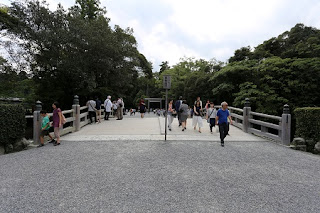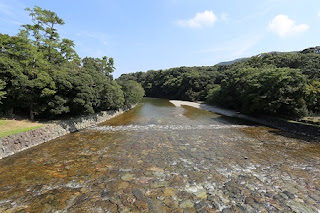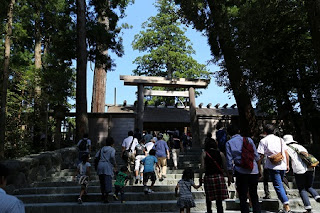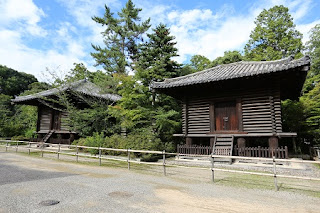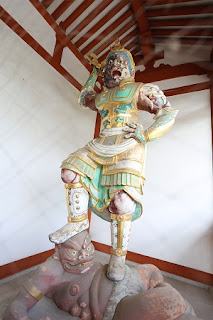Jingu / Ise Jingu
Jingu is often introduced in the dictionary as "Ise Jingu." However, the official name is "Jingu" without "Ise."
Ise Jingu is the most important and popular shrine for Japanese people and several millions of Japanese people visit every year.
Jingu is principally composed of the Naiku where Amaterasu Omikami, the ancestral kami of the Imperial Family, is worshiped, and Geku where Toyouke Omikami, the kami of agriculture and industry, is worshiped.
Naiku is the alternative name for Kotaijingu, the sanctuary that is located in the southern part of Ise city, Mie, and was founded about 2000 years ago.
Geku is the alternative name for Toyoukedaijingu. This sanctuary is located in the center of Ise city, Mie, and was founded about 1500 years ago.
In the area around Jingu, 125 subsidiary shinto sanctuaries are distributed. 91 of them are connected with the Naiku and 32 with the Geku.
Jingu is described in the oldest Japanese books "Kojiki" and "Nihonshoki", edited about 1300 years ago.
Many generations of our ancestors have worshiped at the Jingu, which exists now just as it was at its beginning.(source)
謹賀新年
新年明けましておめでとうございます。東日本大震災による福島第一原子力発電所の事故を契機に始めた当ブログは今年で5年になります。日本が幾多の困難を乗り越えて希望と安全の国になれるよう、今年も応援してまいります。
伊勢神宮について
三重県伊勢市にある伊勢神宮は天照大神をおまつりする皇大神宮(内宮)と天照大神のお食事を司る神の豊受大神をおまつりする豊受大神宮(外宮)を中心とする125の宮社の総称です。外宮から内宮の順に参拝します。
These pictures were taken on August 2015.
About Ise Jingu
Google map
Ise Jingu (Geku)
Google map
Ise Jingu (Naiku)
Toyoukedaijingu / Geku
豊受大神宮/外宮
Geku is the alternative name for Toyoukedaijingu. This sanctuary is located in the center of Ise city, Mie, and was founded about 1500 years ago.
Hiyokebashi Bridge
火除橋
This wooden bridge marks the entrance to Geku
Torii ; a symbolic structure of Shinto
鳥居
Main sanctuary
正宮
The entrance to Main sanctuary
Kotaijingu / Naiku
皇大神宮/内宮
Naiku is the alternative name for Kotaijingu, the sanctuary that is located in the southern part of Ise city, Mie, and was founded about 2000 years ago.
Isuzugawa River
五十鈴川
Ujibashi Bridge
This woodenbridge is newly constructed every twenty years.The architectural style of the Ujibashi Bridge is purely Japanese and its length is over 100 meters.
宇治橋
Torii
Main sanctuary
正宮
A divine palace of Amaterasu-Omikami stands here.
Mishine-no-mikura
御稲御倉
One of the auxiliary jinja of Naiku to store harvested rice for offering to kami in rituals.
Kintetsu Railway
近鉄
Japanese foods are good and safe.
Because of stricter food safety law by Japanese government, we have no worry about foods.
Matsusaka beef
松阪牛
Sushi
寿司
mochi ; rice cake
餅
Anmitsu
あんみつ
About 5 years have passed since Fukushima Daiichi nuclear power plant accident. I have visited various places of Japan to see the health consequence of the accident.
Fortunately I have never found any impacts by the accident among Japanese creatures. As far as I know, nobody has health problem which is caused by the accident in Japan.
Our Prime Minister Abe assures that "The situation is under control. The influence of the contaminated water is completely blocked within Fukushima. There are no health-related problems until now and there will never be health problems." He also said that "Tokyo is 250 kilometers away from Fukushima, and the kind of danger that you imagine does not exist in Tokyo. Tokyo is a very safe city."
As PM Abe said, Mie Prefecture is very far away from Fukushima, people in there have no concern about the nuclear power plant accident. People in there have already forgotten the accident, because they think radioactive materials cannot reach there.
We know there is no problem for childbirth and child rearing in Mie Prefecture. So people in there have no concern about the accident.
I continue to visit various places in Japan to see the effects of the accident, because I can meet various creatures which are more sensitive to radioactive materials from the environment. It is important to see their health for our safety.
Fortunately I have never found any impacts by the accident among Japanese creatures. As far as I know, nobody has health problem which is caused by the accident in Japan.
Our Prime Minister Abe assures that "The situation is under control. The influence of the contaminated water is completely blocked within Fukushima. There are no health-related problems until now and there will never be health problems." He also said that "Tokyo is 250 kilometers away from Fukushima, and the kind of danger that you imagine does not exist in Tokyo. Tokyo is a very safe city."
As PM Abe said, Mie Prefecture is very far away from Fukushima, people in there have no concern about the nuclear power plant accident. People in there have already forgotten the accident, because they think radioactive materials cannot reach there.
We know there is no problem for childbirth and child rearing in Mie Prefecture. So people in there have no concern about the accident.
I continue to visit various places in Japan to see the effects of the accident, because I can meet various creatures which are more sensitive to radioactive materials from the environment. It is important to see their health for our safety.


